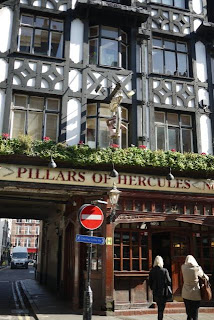Last week, Zoë Wanamaker shared stories about her father, her childhood and her experiences as an actor with a full house at the LJCC. A household name as Susan Harper in the BBC sitcom "My Family" and as Madam Hooch in the first "Harry Potter" film, Zoë has a long and distinguished career in film, TV and theatre.
The evening began with Zoë telling how her family had to move to the UK from the USA when her father, actor and director Sam Wanamaker, was blacklisted during the McCarthy witch-hunts. Zoë was three at the time, and it was only as an adult that she realised how much danger her father had been in. He had decided not to return to the US when “he had been warned that he would be subpoenaed (to court),” she recounts. Zoë tells that her parents’ US passports were “rescinded” making them “stateless” for the next 10 years. Despite this, Zoë remembers her childhood in St John's Wood fondly, saying that it included lots of visits to the theatre, to galleries and an enjoyment of everything London had to offer. She considers herself “very lucky.”
Zoë's father, actor and director Sam Wanamaker (Image courtesy of Wikipedia)
Richard Eyre, who was
interviewing Zoë, and who has directed her in several plays, pointed out that
Zoë is a “natural sceptic and distruster of authority” like her father, with
which she heartily agreed. Zoë was
touched when a member of the audience, celebrated make-up artist Walter
Schneiderman, stood up and explained that he had worked with her father in his first
British film “Give Us This Day,” and even handed her some photographs of her
father which she had never seen before.
Zoë’s father, Sam Wanamaker is perhaps most well known as the founder of the Globe Theatre in London. Zoë remembers how on “Sunday lunches the plans (for the Globe) would come out.” At the time, Zoë admits she was rather “sceptical” of her father’s grand project. Now, looking back, she deeply admires the “great degree of tenacity” he had to push his dream forward and she sits on the theatre’s Board as Honorary President.
Zoë’s father, Sam Wanamaker is perhaps most well known as the founder of the Globe Theatre in London. Zoë remembers how on “Sunday lunches the plans (for the Globe) would come out.” At the time, Zoë admits she was rather “sceptical” of her father’s grand project. Now, looking back, she deeply admires the “great degree of tenacity” he had to push his dream forward and she sits on the theatre’s Board as Honorary President.
Blue plaque to Wanamaker outside Shakespeare's Globe Theatre (Image courtesy of Wikipedia)
As a little girl, Zoë admits she wanted to be a nun –
not because of any religious conviction – but because she liked the singing and
found it very “glamorous.” “Judaism was never pushed down our neck.” Zoë explains, “My parents grew up with Judaism and rebelled against it and
indoctrination in any form.” Still, she remembers her father would
“occasionally feel guilty and then the cantor would go on the record player.”
Zoë’s parents, both of them actors, were not at all keen that she should enter the profession because of the insecurity and rejection involved. They tried to dissuade her, but Zoë decided that she wanted to act. She admits that she is still “looking for answers about acting” and that every acting job is a “challenge.” She describes the development of each character she plays as a “journey” in which the actor is “looking for clues.” She still gets stage fright, and has even on occasion been sick in the wings. But she finds acting, especially in the theatre, unbelievably exciting: “you can feel it if you have an audience, it’s a visceral thing.” For Zoë, working in the theatre is “an exciting event. You want people to enjoy it. It’s all about telling stories.”
Zoë’s parents, both of them actors, were not at all keen that she should enter the profession because of the insecurity and rejection involved. They tried to dissuade her, but Zoë decided that she wanted to act. She admits that she is still “looking for answers about acting” and that every acting job is a “challenge.” She describes the development of each character she plays as a “journey” in which the actor is “looking for clues.” She still gets stage fright, and has even on occasion been sick in the wings. But she finds acting, especially in the theatre, unbelievably exciting: “you can feel it if you have an audience, it’s a visceral thing.” For Zoë, working in the theatre is “an exciting event. You want people to enjoy it. It’s all about telling stories.”
Zoë Wanamaker (Image courtesy of Adrian Dell)









